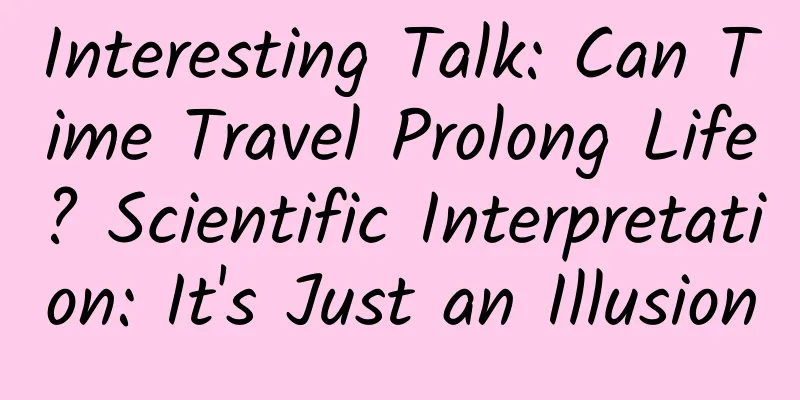The Secret of the Deep Sea Castle: Human, where do you come from?

|
Some mysteries may never be solved. By Amanda Heidt Compiled by Huang Yan "Where am I from?" "Where do I come from?" is one of the three basic philosophical questions, along with "Who am I?" and "Where am I going?". Since the beginning of human civilization, people have never given up exploring their own origins. For thousands of years, countless men of letters, scholars and beauties have paid with their blood and lives for this - fortunately, this only happened in the ignorant age, and now people only need to pay with their time and hair. At present, after dozens of generations of efforts, scientists have basically answered this question to the point of "We evolved from primitive eukaryotes", but the origin of eukaryotic cells is still confusing. So, the question that evolutionists have to answer now is: "We come from primitive eukaryotic cells, so where did the primitive eukaryotic cells come from?" In 2022, biologist López-García from the University of Paris-Saclay and his colleagues embarked on a journey to continue exploring the origin of life. To this end, they went to one of the driest places in the world - the shrub-covered, gravelly plateau in the northern Atacama Desert in South America. Visitors are not welcome there, but there may be clues to the origin of complex life. Surrounded by mountains and sand dunes, there are small pools of warm and bitter water. The bacterial carpet composed of cyanobacteria and archaea is like a thousand-layer cake, layer upon layer - for them, it may be a rare oasis in the desert. López-García calls it the "primitive forest", meaning a "complex" ecosystem that existed long before the explosion of species on Earth. Scientists now use these tiny ecosystems to simulate ancient ecosystems because they must have appeared no later than the first appearance of eukaryotes. The bacterial carpet may mimic the conditions that gave rise to eukaryotic life on early Earth. DIVERSITY, ECOLOGY AND EVOLUTION OF MICROBES (DEEM)/PURIFICACIÓN LÓPEZ-GARCÍA Each layer of these fungal mats has different kinds of microorganisms that support each other. The main occupiers of the surface with abundant light and oxygen are cyanobacteria, which are the earliest photosynthetic oxygen-releasing organisms. Their appearance changed the earth's environment from low oxygen to oxygen, which provided the material basis for aerobic respiration later - let us say "thank you cyanobacteria" together. Here, cyanobacteria not only feed humans, but also heterotrophic organisms in the low oxygen environment of the lower fungal mat feed on the byproducts of cyanobacteria. The lower layer of the fungal mat is black and smelly, which is the result of microorganisms reducing sulfate and producing methane in anoxic environments. It is not easy for everyone to live here. They feed on each other's metabolic waste - everyone feeds each other with shit and urine. This kind of relationship of mutualism is scientifically called "mutual trophic symbiosis" or "nutritional symbiosis". López-García said that this temporary mutually beneficial symbiotic relationship may gradually stabilize over time and evolve into a permanent relationship - dating until old age, that's probably what it feels like. In this environment, individuals of different species of microorganisms can nest together to form a relatively stable entity. Scientists suspect that this entity is the prototype of early complex eukaryotic cells. Over a long period of history, this most primitive "cell" gradually occupied the mainstream ecological niche and thrived into a stable eukaryotic cell, and eukaryotic cells with different divisions of labor united in a similar way, eventually becoming the diverse macroscopic life today. This process is called " eukaryogenesis ". The definition of eukaryogenesis is still controversial, but it generally refers to the evolutionary process of the surge in cellular complexity 1 to 2 billion years ago. During this period, some iconic features of modern eukaryotic cells, such as the nucleus, mitochondria, cytoskeleton, cell membrane, and chloroplasts, made their debut. These features appeared between the first and last common ancestors of all eukaryotic cells. According to the acronym, the former is called FECA (First Eukaryotic Common Ancestor) and the latter is called LECA (Last Eukaryotic Common Ancestor). But many details in this process remain unresolved. What did the earliest eukaryotes look like? What kind of relationship might they have with other organisms? How do their molecular mechanisms work and how do they evolve? ... These mysteries remain to be solved. Scientists have not yet reached a consensus on important questions such as "in which branch of life it sprouted" and "which microbial participants may have contributed to this." However, the "Asgard archaea" identified in recent years has once again revitalized the discussion about the origin of eukaryotes. This archaea, named after Norse mythology, is "the closest relative of contemporary eukaryotes." It provides evidence for past discussions and introduces new questions. Some researchers believe that this is the most exciting development in biology at present. "People are discovering so much, and so many predictions are being verified." The Norse Temple of Asgard Appears In 2013, Anja Spang, who had obtained a PhD in evolutionary microbiology, was looking for a postdoc position. His PhD thesis was on a group of archaea called Thaumarchaeota (now renamed Nitrososphaerota). During his PhD, Anja discovered that the genomes of these archaea and some other archaea contain genes encoding " eukaryotic signature proteins (ESP)". They are called eukaryotic signature proteins because they are characteristic proteins in eukaryotic cells, which means they should not appear in archaea - but they do. With this question in mind, Anja Spang joined the research group of Professor Thijs Ettema at Uppsala University in Sweden and began his journey to explore the deep sea. (The translator himself graduated from Uppsala University in Sweden. When he saw this paragraph, he said: I ate the melon and ate my own home.jpg) Loki's Castle, a group of five active hydrothermal vents in the mid-Atlantic Ocean. (Image Credit: Centre for Geobiology BY RB Pedersen) More than 2,300 meters below the surface of the North Atlantic Ocean between Norway and Greenland, there is a pile of seabed sediments called "Rocky Castle", from which Ettema's team intends to extract genomes. The initial sample was less than a teaspoon of seabed mud, but during the analysis, the software used to annotate and analyze genetic material returned strange results - this is actually okay, scientific research experience shows that unexpected and unsatisfactory results are good because they are likely to be true. The software marked homologous genes of the gene encoding actin. Actin is used in eukaryotic cells to maintain cell morphology and is a typical eukaryotic characteristic protein. It obviously should not appear in archaea. So the homologous genes marked by the software come from a new group. In 2015, Ettema's team published an article in Nature magazine, naming the gene Lokiarchaeota, where "Loki" is a tribute to Loki in Norse mythology. In the following years, the team gradually enriched this group and named it the "Asgard superphylum", which includes groups named after Norse gods such as Thor, Odin, and Heimdall, in addition to Loki - these gods all live in the Asgard Palace, and the most important thing for a family is to be together. Since then, researchers have discovered other eukaryotic characteristic proteins in the above-mentioned "family", such as homologs of proteins involved in various physiological processes from ubiquitin signaling to gamete fusion. Eukaryotic characteristic proteins are very common in this family, indicating that these microorganisms may be the closest existing prokaryotes to modern eukaryotes. And modern eukaryotes are likely to have inherited their molecular operating mechanisms from archaea. Traditionally, people believed that modern eukaryotes evolved from ancient bacteria or so-called "proto-eukaryotes." But now this view is about to be overturned. Most scientists now believe that the common ancestor of existing eukaryotic cells is the ancestor of the Asgard supersystem, or another group of similar ancient karyotes (archaea). In 2019, researchers successfully cultured organisms from the Asgard supersystem for the first time, allowing them to study the family in more depth. They found that one cultured species was small and slow-growing, dividing only once every two to three weeks, while other microorganisms could double in just minutes or hours. They named the former "Candidatus Prometheoarchaeum syntrophicum" (obviously the name comes from Prometheus), and Candidatus Prometheoarchaeum syntrophicum and another group of archaea called "Methanogenium" live in close symbiosis. The former obtains nitrogen and energy by digesting amino acids and peptides, producing hydrogen in the process, which is absorbed and utilized by the latter. This process can reduce the hydrogen content in the microenvironment, thereby relieving cellular stress. Scientists studying the Asgard supersystem believe that this symbiotic relationship may be a model for eukaryotic occurrence. Asgard archaea were first identified from metagenomic data in 2015 and are considered the closest living prokaryotes to modern eukaryotes. A few years later, the first Asgard archaeon, Candidatus Prometheoarchaeum syntrophicum, was cultured, revealing unique aspects of its biology. HIROYUKI IMACHI, MASARU K. NOBU, AND JAMSTEC This symbiosis has also been detected at the genetic level in other archaea, but the relationship between Candidatus Prometheoarchaeum syntrophicum and Methanogenium provides solid evidence for this, says Anja Spang. Years later, Anja, who has successfully landed and established her own research group at the Royal Netherlands Institute for Sea Research, recalls: "When I first learned that the paper describing this organism and its nutritional symbiosis was finally published, I was very happy from the bottom of my heart. This proves that this kind of experimental work is meaningful for metabolic predictions of the Asgard supersystem." Controversial Eukaryotic Hypothesis These early observations sparked a flood of research—and spam. In the following years, hundreds of preprints on bioRxiv appeared on the Internet regarding the Asgard supersystem and eukaryogenesis. The most direct impact of the above discovery is that eukaryotes and archaea are placed in the same domain , thus reducing the three-domain tree of life model consisting of eukaryotes, prokaryotes and archaea to a two-domain model. (Translator's note: "Domain" is the largest unit in biological taxonomy. A domain has several kingdoms, followed by the familiar phyla, classes, orders, families, genera and species; for example, humans belong to the Eukaryota domain, the Animalia kingdom, the Chordata phylum, the Mammalia class, the Primates order, the Hominidae family, the Homo genus, the Homo sapiens species...) People once believed that bacteria and archaea were both prokaryotes, but with continuous research in planned biology, people discovered that the differences between archaea and other prokaryotes were becoming increasingly greater, so they separated archaea and classified them as archaea. In the traditional three-domain model, eukaryotes and archaea have a common ancestor but belong to different branches. Research in the field of systems biology in recent years has shown that complex eukaryotic cells originated from archaea. This allows eukaryotes and archaea to be divided into the same domain. People had been arguing about the two-domain system before the discovery of the Asgard supersystem, but the Asgard supersystem provides more evidence for it. The two-domain hypothesis also supports the theory that eukaryotes came from archaea, rather than the so-called "proto-eukaryotes". 01Which came first, the cell or the mitochondria? Many scientists believe that the first eukaryotes evolved from a collaboration between archaea and bacteria. Somehow, the bacteria found their way into the archaea and became organelles such as the nucleus and mitochondria—the defining hallmarks of eukaryotic life. The details of how this happened are still murky, but the most likely clue came from the mitochondria. “There’s DNA in the mitochondria that goes back to alphaproteobacteria,” says Laura Eme, an evolutionary microbiologist at France’s National Centre for Scientific Research (CNRS). “It’s a sure thing, even if we don’t know the exact route.” α-Proteobacteria is a class under the Proteobacteria. There are great differences among them, and few similarities, commonly known as the "bulk class". Most α-Proteobacteria are Gram-negative, and typical members include plant symbionts such as Rhizobia, endosymbiotic bacteria such as Wolbachia, and intracellular parasites such as Rickettsia. Some people believe that α-Proteobacteria are on the way to transforming into organelles, and the current organelles are α-Proteobacteria that have already landed and have been "organized" in the cell. Even if there is a solid evidence for gossip, the public will still dig up the details - scientists are no exception. There have always been different and even contradictory hypotheses about the process of α-proteobacteria "taking the exam" in cells. How did α-proteobacteria enter the cell? Scientists pondered for a long time, but still couldn't figure it out: the endocytosis process consumes a huge amount of energy. For such a luxurious physiological function, did mitochondria first appear to provide energy for this process, and then cells evolved endocytosis, or did endocytosis first appear before mitochondria could be swallowed into cells? Therefore, scientists are divided into two camps, "mitochondria first" and "endocytosis first", and they have engaged in verbal battles in academic journals. In any case, the function of endocytosis has not been observed in prokaryotes for a long time. Until recently, researchers discovered a "quasi-endocytosis" in a bacterium. Laura Eme commented: "Many people think that prokaryotes cannot endocytose in the past, so the ancestor of mitochondria cannot be swallowed into cells. But now, at least we know that prokaryotes can endocytose." This is where subjects like biology and chemistry are so torturous - unlike mathematics, physics and other subjects that are concise and formulaic, chemistry and biology are always full of exceptions. For example, the description of "Beijingers" in mathematics and physics may be "People with ID numbers starting with 110 are Beijingers." Regardless of whether this statement is right or wrong, at least there is a clear standard for judgment. The statement of chemistry and biology is closer to "People who like to drink douzhi are Beijingers, but we found that some people were born in Beijing but don't like to drink douzhi, so we define them as 'broad Beijingers', and the traditionally defined Beijingers are called 'classic Beijingers'; now we have the 'super-Beijinger domain', which can be divided into 'classic Beijingers' and 'broad Beijingers of non-classic Beijingers'; then we found some people who also like to drink douzhi but are not Beijingers, so we call them 'pseudo-Beijingers'..." In addition, preliminary observations of the Asgard supersystem revealed an additional engulfment mechanism. When scientists first cultured Candidatus Prometheoarchaeum syntrophicum, they noticed some slender protrusions on the surface of the cell body - extensions of membrane structures called "bubbles". With the help of the actin homologs mentioned above, these bubbles may be able to surround an external entity and fuse together, thereby enclosing the foreign object. In this way, the puzzle of phagocytosis "is becoming less and less of a problem." In other words, α-proteobacteria are likely to be "swallowed" into prokaryotes and become mitochondria. 02How did the cell nucleus appear? However, when it comes to the cell nucleus, things are not so clear. It is generally believed that the most typical feature that distinguishes eukaryotes from prokaryotes is "the presence of a cell nucleus." The speculation about the origin of the cell nucleus ranges from "bacteria hosted in amoeba" to "remnants of ancient giant viruses." In the 1990s, López-García proposed the "nutritional symbiosis hypothesis" for the origin of eukaryotes, assuming that there is a symbiotic relationship between two bacteria and an archaeon. After the discovery of the Asgard supersystem, López-García and her colleagues updated this hypothesis a few years ago. Instead of using archaea as the original host, they proposed the concept of an "archaeon". In their hypothesis, the "archaeon" is an archaeon that can produce hydrogen and is similar to the organisms in the Asgard supersystem, and is also the original cell nucleus. The host that accepted such a "nucleus" is most likely a type of δ-proteobacteria, the ancestor of mitochondria and α-proteobacteria. Most of the genes in modern eukaryotes actually come from bacteria, not archaea; the lipids that make up the cell membrane of eukaryotic cells are closer in structure and composition to bacteria than to archaea (a phenomenon called "lipid divide") - these facts support their hypothesis. And their hypothesis is the only one so far that can explain both the origin of the nucleus and the phenomenon of lipid divide. Michelle Leger is a postdoctoral fellow in evolutionary microbiology at the Institute of Evolutionary Biology in Barcelona. Her main work is to trace the origins of existing archaeal genomes to support or oppose various current hypotheses. Regarding the "nutritional symbiosis hypothesis" proposed by López-García and others, Leger said that there are clear genomic signals of α-proteobacteria in mitochondria, but he has not found similar signals of δ-proteobacteria in the nucleus. Leger also believes that the current evidence does support the conclusion that "the origin of the cell nucleus is archaea." Although archaeal genes only account for a small part of the current nuclear genome, many of these genes are highly conserved. For example, the genes responsible for DNA replication and transcription are largely derived from archaea. Therefore, Leger believes that "these hypotheses make sense, but we still don't know what other organisms are involved in these evolutionary processes." Uncovering a new pathway for eukaryotic development Many researchers say that even though the number of sequenced bacterial and archaeal species is increasing rapidly, providing new clues to clarify the relationship between such organisms and the early origin of eukaryotes, it is regrettable that many questions in this field may never be perfectly answered. Eukaryotes have been around for too long, and too many genes have been exchanged and passed between too many species. It is impossible for scientists to piece everything together, but they are still trying. The research methods widely used in academia include omics, molecular biology, and fossil research. The next good place to start will be functional studies of modern eukaryotic genomes and proteomes. Studying function can give clues to how individual genes and proteins behaved in early ancestors. A few years ago, there was only one Asgard superlineage genome, but now there are hundreds of such groups, and researchers are unearthing their details. "Now we know exactly which genes in eukaryotes were inherited from Asgard archaea, and there are a lot of novelties here," says Laura Eme, "but what we don't know is what these genes did and what they are doing in the Asgard superlineage - and that's the trick." Remember the suspected homologous genes encoding eukaryotic actin genes in archaea mentioned earlier? In 2020, researchers synthesized such homologous genes in the Asgard supersystem genome. They injected these homologs into rabbit cells and found that they could bind to eukaryotic actin and perform similar functions, such as assisting calcium ions to cross the membrane. This shows that the calcium-controlled actin cytoskeleton may have existed in archaea before the emergence of eukaryotes. In addition to cultivating archaea to study their functions, some people directly study "microfossils". Microfossils are microscopic imprints of early cells in rocks. Susannah Porter, a paleontologist at the University of California, Santa Barbara, believes that fossil research may also reveal the path of eukaryotic occurrence. She said that when metagenomic sequencing appeared, fossils seemed to fall out of favor, but many phylogenetic trees rely on a method called "molecular clock", that is, fossils are used to anchor the analysis time. In addition, fossils themselves may also be useful. They can help scientists determine when certain external features first appeared. The specimens that Porter is studying can determine the order of some events in the evolution of early eukaryotes. "We do have fossils from the past 2 billion to 1 billion years, and they have not been fully utilized. Maybe we can use these characteristics of fossils to piece together the origin of eukaryotic cells." In short, at present, although genomics and molecular biology have developed to a certain height, traditional fossil evidence still plays an important role in the study of microbial evolution and eukaryotic occurrence. 750-million-year-old microfossil Valeria lophostriata COURTESY OF SUSSANAH PORTER In order to avoid "isolated evidence", scientists are also looking for other evidence to support fossil evidence. For example, Berend Snel, a computational biologist at Utrecht University in the Netherlands, recently used a method called "gene duplication segment" to conduct research. This method assumes that the length of each branch on the phylogenetic tree is related to its development time. However, this method is controversial, so much so that Snel himself has to admit that it may have flaws. But Snel also said that evolution is a continuous process, and only when people connect small fragments of this long process together, the true and complete evolutionary map will be presented to people. Michelle Leger agrees that our current understanding of eukaryotic evolution is like that of a baby's understanding of the world. "Part of the nature of these deep evolutionary questions is that we will never know and will never have a definitive proof of our hypothesis, but that doesn't stop us from continuing to refine our ideas. Alternative hypothesis: Viruses are the ancestors Much about the origin of the cell nucleus is speculative. One hypothesis is that the nucleus of modern eukaryotes may have emerged from a partnership between a prokaryotic host and a virus. At the beginning of the 21st century, Masaharu Takemura, a molecular biologist at Nagoya University School of Medicine in Japan, noticed that the DNA polymerase of a group of viruses (poxviruses) was very similar to that found in eukaryotes, and that poxviruses replicated within host cells by creating "isolated compartments." At the same time, Philip Bell, head of research and development at the biotech company MicroBioGen, was also puzzled by the differences between eukaryotes and bacteria. For example, eukaryotic chromosomes are linear, while bacterial chromosomes are circular. Many features of the nucleus do not support a bacterial origin. Both researchers published their papers in 2001. And after learning about the Asgard supersystem and its research results, both research groups updated their hypotheses on the origin of viruses. Since then, researchers have identified giant viruses, first discovered in 2003, that are much larger than most viruses, have large enough genomes, and have genes related to various metabolic processes. Now, Masaharu Takemura, Philip Bell, and others believe that this giant virus may be the original cell nucleus. Giant viruses replicate in complex compartments that look very similar to modern cell nuclei. They are all large, contain inner and outer membranes, and carry genes that encode proteins required for the operation of host cells. However, the idea that the nucleus may have come from a virus has been a difficult sell. It lacks structural evidence and is not supported by existing data. However, Valerie De Anda, a microbiologist who studies the metabolism of early prokaryotes, is not deterred by the current lack of evidence to support the "virus hypothesis." She and her colleagues are currently looking for mRNA capping genes involved in transcription and translation. They believe that these genes came from the "ancestor of the first eukaryotic nucleus" long ago. When talking about the fact that her theory is not widely accepted by the scientific community, Valerie De Anda was somewhat upset. This reminded her of an ancient Chinese poem that her teacher taught her when she was in school: Since childhood, I have been in the deep grass. Now I gradually feel the weeds appearing; People at that time did not know the towering tree. Only when you reach the sky do you realize how high you are. References [1] Shiratori, T., Suzuki, S., Kakizawa, Y. et al. Phagocytosis-like cell engulfment by a planctomycete bacterium. Nat Commun 10, 5529 (2019). https://doi.org/10.1038/s41467-019-13499-2 [2] Martin William F., Garg Sriram and Zimorski Verena (2015) Endosymbiotic theories for eukaryote originPhil. Trans. R. Soc. B3702014033020140330 http://doi.org/10.1098/rstb.2014.0330 [3] Moreira, D., López-García, P. Symbiosis Between Methanogenic Archaea and δ-Proteobacteria as the Origin of Eukaryotes: The Syntrophic Hypothesis. J Mol Evol 47, 517–530 (1998). https://doi.org/10.1007/PL00006408 [4] Caforio, Antonella et al. “Converting Escherichia coli into an archaebacterium with a hybrid heterochiral membrane.” Proceedings of the National Academy of Sciences of the United States of America vol. 115,14 (2018): 3704-3709. doi:10.1073/pnas.1721604115 [5] Vosseberg, J., van Hooff, JJE, Marcet-Houben, M. et al. Timing the origin of eukaryotic cellular complexity with ancient duplications. Nat Ecol Evol 5, 92–100 (2021). https://doi.org/10.1038/s41559-020-01320-z [6] Chaikeeratisak, Vorrapon et al. “Assembly of a nucleus-like structure during viral replication in bacteria.” Science (New York, NY) vol. 355,6321 (2017): 194-197. doi:10.1126/science.aal2130 [7] Mills, Daniel B et al. “Eukaryogenesis and oxygen in Earth history.” Nature ecology & evolution vol. 6,5 (2022): 520-532. doi:10.1038/s41559-022-01733-y This article is authorized to be compiled from: This article is supported by the Science Popularization China Starry Sky Project Produced by: China Association for Science and Technology Department of Science Popularization Producer: China Science and Technology Press Co., Ltd., Beijing Zhongke Xinghe Culture Media Co., Ltd. Special Tips 1. Go to the "Featured Column" at the bottom of the menu of the "Fanpu" WeChat public account to read a series of popular science articles on different topics. 2. Fanpu provides a function to search articles by month. Follow the official account and reply with the four-digit year + month, such as "1903", to get the article index for March 2019, and so on. Copyright statement: Personal forwarding is welcome. Any form of media or organization is not allowed to reprint or excerpt without authorization. For reprint authorization, please contact the backstage of the "Fanpu" WeChat public account. |
>>: Shocked! The prototype of "Patrick Star" is so indescribable!
Recommend
Transferring patents to Ericsson, the patent troll that defeated Huawei, is a wise move
Unwired Planet is a patent-holding company that p...
Is it true that we cannot use air conditioning all the time in summer?
This year has entered the dog days The dog days w...
Symantec: Millions of Android apps are malware
Editor's note: This seems to need no further ...
iOS 15 is reported to have bugs and no highlights
[[425492]] This Tuesday, Apple pushed the first o...
6 great templates for advertising creativity!
Many people think that creativity is mysterious a...
Mother's Day copywriting is here, here is a secret to seduce your mom!
This Sunday, May 13th is Mother's Day . In ad...
Nokia X/Asha501 comparison experience
Although it is an Android system, Nokia X is diffe...
The beauty of festivals · Beginning of Summer丨When is the beginning of summer and how is it determined?
After welcoming the beginning of summer on May 5 ...
A major reshuffle of the top 15 automakers in November 2017
According to the latest data released by the Chin...
How to write a planning proposal? The process and skills of operating promotion plan
For marketers, making marketing plans is a common...
What is the real Ordos like?
Ordos In most people's impression It is a nor...
Is it technically possible to bring everyone in the country into one WeChat group?
According to WeChat public data, in September 201...
A 7.4-magnitude earthquake struck the Fukushima coast. Are nuclear power plants safe?
Author: Gao Yali and Feng Lifei On the evening of...
I am a tomb keeper in Xinzheng
An anti-tomb-robbing novel that makes your blood b...
Mushicheng manager class courses, Mushicheng e-commerce college official website!
Mushicheng manager class courses, Mushicheng e-co...









